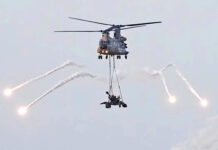Indigenous Carbine
A new joint venture protective carbine (JVPC) has successfully passed the final phase of user trials, meeting all criteria of the General Service Qualitative Requirement (GSQR), the Ordnance Factory Board (OFB) has announced.
The compact gas-operated weapon has an effective range of more than 100 metres and weighs less than three kilos. During the tests, the ammunition penetrated 3.5 mm thick mild steel plate and 23 layers of soft armour at 100 metres, the OFB said in a statement.
The weapon can be fired with one hand. It has a rate of fire of 800 rounds per minute. The JVPC, which feeds through the pistol grip unlike any other indigenously developed weapon in 5.56 x30 mm calibre, is being issued to Central paramilitary forces and state police organisations, Gagan Chaturvedi, deputy director general, OFB, said in a statement.
The weapon features a 30-round steel magazine, semi bull-pup design, retractable butt, low recoil and multiple rails for mounting lights, laser pointers and optical sights.
The carbine has been jointly developed by the Defence Research and Development Organisation (DRDO) and the OFB which has its headquarters in Kolkata. It is manufactured at the Small Arms Factory, Kanpur, while the ammunition is produced by Ammunition Factory Khadki in Pune.
The weapons earlier cleared the trials of the Directorate General of Quality Assurance, Chaturvedi said.
Indigenous Artillery Gun Trials to Resume
Winter and summer trials of the indigenous Advanced Towed Artillery Gun System (ATAGS) developed by the Defence Research and Development Organisation (DRDO) jointly with private industry are scheduled to be resumed and completed by mid 2021.
Trials which began in September 2020 were paused after the gun suffered a barrel burst and an investigation was under way to determine the cause.
The ATAGS is a 155mm, 52 calibre artillery gun jointly developed by the DRDO in partnership with Bharat Forge of the Kalyani Group and the Tata Power SED.
In August, 2018 the Defence Acquisition Council had accorded approval for the purchase of 150 of these guns at an approximate ?3,365 crore which would be split between the two companies. The deal will be split in 60:40 ratio between thee lowest bidder (L1) and L2.
Once the user trials are over, the Army has to give the Request For Proposal (RFP) and the initial lot can be supplied immediately, the official said. The Army requires 1,580 guns in this category and Israeli firm Elbit Systems was shortlisted for a tender floated to procure them.
In September, the ATAGS had suffered a barrel burst during trials which have since been stopped. A committee was set up consisting of DRDO scientists, Army representatives and the Ordnance Factory Board (OFB) officials to determine the cause and submit an evaluation report.
The price has not yet been determined and for now it is only for the initial limited order. Price for the bigger order of 1,580 guns has to be negotiated.
First Batch of Negev LMGs Received
Indian Army has received the first batch of Negev Light Machine Guns (LMG) from Israel as it seeks to boost the firepower of frontline troops.
In 2020, the defence ministry signed a Rs8.8bn ($120.57m) capital acquisition contract with Israel Weapons Industries to procure 16,479 LMGs under the Fast Track Procedure.
In the first batch, 6,000 guns were delivered, while the remaining units are expected to be supplied by March.
The weapons are currently undergoing inspections, according to local media sources.
The Negev 7.62X51mm LMG is a combat-proven weapon system and is used by several countries. The LMG has a higher range, as well as greater lethality compared to the currently used weapons system by the Indian Armed Forces.
The LMG was needed to meet urgent operational requirements. Notably, India has been engaged in a border standoff with Chinese forces in the Ladakh region since May. Recently, the two sides held the ninth round of talks to resolve the impasse.
The military face-off has accelerated defence acquisitions and development in India.
High Mobility Vehicles Ordered
Public sector defence equipment manufacturer BEML Limited has received orders from the Ministry of Defence (MoD) for supply of High Mobility vehicles, which play a key role in the logistics management of the Indian Army leveraging on its exceptional cross country capabilities.
The high mobility vehicles (HMV) will help in the transportation of armoured fighting vehicles, troops, ammunition and stores to far-flung, difficult terrains in operational areas.
At an approximate value of Rs 758 crore, the equipment will be supplied to Indian Army in a span of one year after manufacturing them at BEML’s Palakkad Plant in Kerala.
Patrol Boats for Pangong Lake
The Indian Army has finalised procurement of 12 high-performance patrol boats to enhance its surveillance of large water bodies, including the Pangong Lake in eastern Ladakh where India and China are locked in a bitter border standoff as well as for other water bodies.
The Army said it inked a contract with Goa Shipyard Ltd, a state-run public sector undertaking, for 12 fast patrol boats for surveillance and patrolling of large water bodies, including those in high altitude areas. Delivery would commence from May 2021.
In a statement, Goa Shipyard Limited (GSL) said it signed a contract with the Indian Army for supply of the ‘high performance specialised patrol crafts’ on Thursday and that they will be fitted with specialised equipment to meet the requirement of the force.
Nearly 50,000 Indian Army troops are deployed in a high state of combat readiness in various mountainous locations in eastern Ladakh in sub-zero temperatures as multiple rounds of talks between the two sides have not yielded concrete outcome to resolve the standoff.
Indian troops occupied a number of strategic heights in the Mukhpari, Rechin La and Magar hill areas around the southern bank of the Pangong lake after the Chinese military attempted to intimidate them in the area on the intervening night of August 29 and 30, 2020.
The Pangong lake and areas around it are considered very important. India has stepped up surveillance of the lake after the standoff began in early May 2020.



















